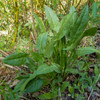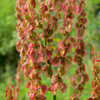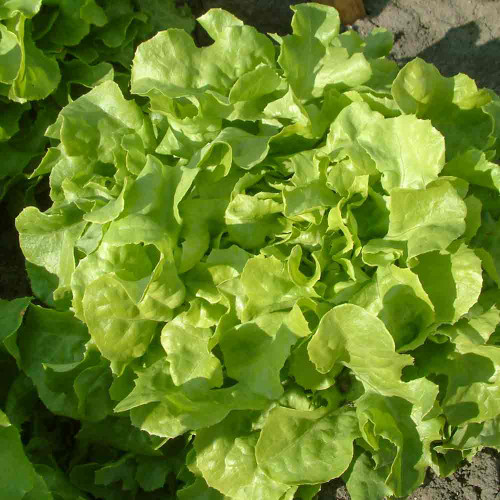Description
Large Leaf Sorrel – Elevate Your Plate with Zesty Elegance
This unassuming bright-green leafed plant is one of the places where nature unfolds a culinary wonder. Its leaves hold tangy delights, an herbaceous sensation that graces your garden with its bright greenery and tantalizes your taste buds with a zesty, lemony kick. Whether you're a seasoned chef or a home gardening enthusiast, this charismatic herb adds a dash of excitement to your culinary adventures.
Large leaf sorrel is a game-changer in your kitchen. Toss it into salads, sneak it into soups, or let it steal the show as a garnish – this herb knows how to make an entrance. It's ridiculously easy to grow, with a little sunlight and some water, and you've got yourself a major flavor source.
Details
Large leaf sorrel is a hardy, deep-rooted plant that grows in thick, mounded clusters, reaching 2’ tall. Multiple stems produce large, soft, light-green leaves growing from a center rosette, reaching several inches long. The leaves are broad at the stem, looking like a cross between arugula and spinach with their elongated arrow shape, and offer a bright, tart, lemon-like flavor. They are often harvested young – around 3” – for their tender texture and milder flavor.
Extremely easy to grow, sorrel is a cold-hardy perennial that dies back in the fall, reappearing in late winter the following year. As it awakens, the new young leaves that first emerge in spring are prized for their tender and delicious lemon-zest flavors that brighten late-winter cooking with the promise of warmer weather. Young leaves can be harvested all growing season long, even when in flower, from May through June, and producing seed from June to August.
Male and female flowers grow on separate plants. – the male grows many small red flowers, while the female produces a naked blossom, resulting in tiny, triangular seeds. Sorrel is in the buckwheat family, as seen by the seed resemblance.
Sorrel is known by many names across the world, such as Acedera, Acedera Común, Azeda-Brava, Common Sorrel, Field Sorrel, Garden Sorrel, Oseille, Oseille Commune, Oseille des Champs, Petite Oseille, Petite Oseille des Brebis, Red Sorrel, Rumex acetosa, Rumex acetosella, Sheep's Sorrel, Sorrel Dock, Sour Dock, Surette, Vignette, Vinette, Wiesensauerampfer.
History
Large leaf sorrel is a multi-faceted herb grown and used for many centuries, as seen by its multiple names from different cultures. Some food organizations claim that “sorrel” is derived from the old French word “surele”, meaning sour. Others say sorrel comes from a High Germanic word that means, you guessed it, sour.
Ancient Greeks and Romans used the herb to promote digestion and considered it an excellent complement to rich, fatty meals, while Roman soldiers would hold a couple of leaves in their mouths during marches to alleviate thirst.
Considered native to Europe and Asia, sorrel was well-known, highly regarded, and widely used long before it became popular in European and British royal cooking from the early Middle Ages into the late 19th Century. Henry VIII knew sorrel well and ate it regularly in Sorrel Soup, a mainstay of English court cuisine. It was often paired with spinach or pureed into cream soups because the young, tender leaves dissolved in hot soups or creams for an ideal flavoring. The lemony tang often emphasized the flavors of other ingredients in a dish.
It likely traveled to early America with colonists and has become naturalized across much of North America, thanks to its ability to reseed readily and adaptability across nearly all fifty states.
Today, it is widely distributed in temperate regions worldwide, thriving in undisturbed patches along fence lines, corner spots, and other boundary areas, preferring moist soil but adapting well to drier conditions. It is considered indispensable in traditional soup variations from France to Ukraine, such as the classic French soupe aux herbes and the always-popular Ukranian shchaveloviy borscht, or green borscht.
Rare and often pricy at farmer’s markets, this unique herb is easy to grow in your home garden.
Uses
Large leaf sorrel is a highly beneficial plant for your garden, with many culinary uses and medicinal properties, and it improves your soil.
Large leaf sorrel blends perfectly with other spring herbs such as dill, chives, and watercress and complements spring foods like new potatoes, salmon, soft-shelled crab, peas, strawberries, and spinach.
The leaves are best used fresh when young, tender, and mild. Use them as a garnish or add to sandwiches and salads alongside milder-tasting greens. Older, larger leaves work better in slow-cooked dishes, as they have a sharper flavor. The leaves dissolve with long cooking times as they impart their lemony flavor, becoming an excellent addition to soups and stews, like cream of sorrel soup. They can be sautéed similarly to spinach, used as a flavoring agent in omelets or casseroles, pureed into sauces, or even used to wrap tougher cuts of meat because their natural acidity can help tenderize the meat while stewing or braising.
Renowned Israeli-British chef Yotam Ottolenghi raves about sorrel, “For sorrel to shine in a spring soup, say, the onions must be softened slowly, so their natural sweetness comes out, while you need the addition of potatoes or fresh shelled beans to cushion the sorrel's kick (red lentil and sorrel soup works for much the same reason).
Used raw in a salad, this lemony leaf works best against soft herbs such as chives or parsley, with a few bitter leaves and dressed simply in olive oil. And if you've shredded it into an omelette, sorrel needs only some grated, creamy cheese or a few snipped chives for company.”
It’s often one of the first greens to appear in springtime, sometimes under snow cover, along with parsley and thyme.
Make your own signature lemon-flavored condiment with dried sorrel powder with an equal amount of sea salt. It’s best to dry the leaves in a dehydrator set to 130°F for at least six hours or until they crumble when touched. Grind in a mortar and pestle or blender until powdered.
Medicinally, it is used to reduce pain and inflammation in the sinuses due to the tannins it contains, which have a drying effect to reduce mucous production. It contains high levels of vitamins A and C, iron, and antioxidants.
Sorrel is considered a dynamic accumulator in soil, drawing nutrients and minerals from the soil, making them more bioavailable to other plants while reducing soil compaction with its taproot.
Companion Planting
Sorrel grows well with many other garden crops, making it even more helpful in addition to its culinary and medicinal benefits. Herbs such as rosemary, sage, and thyme are good companions, as they help keep aphids away from the sorrel. Plants in the mint family – like basil, rosemary, sage, and thyme – repel destructive pest insects like aphids, fruit flies, and thrips by the volatile chemical compounds that make up their scent. We find them attractive, but most pest insects are strongly deterred.
Sorrel does well next to peppers and tomatoes – make sure to plant the sorrel to the south of the peppers or tomatoes so they don’t shade out the lower-growing sorrel.
Pest and Disease Management
Aphids are about the only concern with large leaf sorrel, as it is too acidic and sour for most deer, gophers, groundhogs, or rabbits to eat. Soft-bodied pests like slugs and caterpillars likewise leave sorrel alone.
Companion planting with aphid-deterring plants is the surest bet to keep aphids controlled.
Planting Tip
Sorrel prefers rich, well-drained, moderately acidic soil, but it tolerates almost any soil with consistent moisture. Over three years, we grew a couple of sorrel plants in our raised beds with alkaline soil and lots of heat, sun exposure, and winds. The key was our drip system on a timer that kept the soil moisture consistent – if the tomatoes were happy, the sorrel was also.
Sorrel is at home in containers or large pots as well as in the garden, as long as it has sun and soil moisture. Use a large pot – 12” is a good start. Ensure your container soil drains well, as sorrel dislikes persistently damp soil. Growing indoors is like outdoors in containers – a well-lit room with well-drained, slightly damp soil.
Due to its strong taproot, sorrel doesn’t transplant well, so direct-sow in your garden one to two weeks before your last expected frost date. Sow about 1/4” deep and 12” apart if you plan to harvest heavily or 18” apart if you want to let them grow a bit. Cover lightly with compost, water gently, and let the warming soil do the rest.
If you are starting sorrel in a container, the ideal soil temperature for best germination is 50 - 70°F, with the seeds sprouting in 7 - 21 days.
If you don’t have naturally rich soil, poke your thumb into the soil up to the first joint, then fill it with well-aged compost or organic fertilizer to feed the seed and young plant.
Growing Tip
Water at the soil surface, not overhead, to keep the tender leaves from being burned by the water droplets acting as a magnifying glass for the sun. If the soil dries too much, the plant will wither, stunting its growth and affecting flavor for the rest of the season. A good rule of thumb is 1” of water per week unless it’s hot – above 90°F for most of the day – then water as needed to keep the soil slightly damp 3-6” deep.
In marginal soil, scatter well-aged compost around the young plants and again halfway through the growing season. Organic matter feeds the plant, ensuring good leaf growth and the best flavor.
In hot climates, growing sorrel in a large container in the shade or on the north side of the house can be beneficial, as it moderates the heat and evaporative effects of the sun. Use a large pot – 12” wide is preferable.
Harvest Tip
You can start harvesting sorrel leaves when the plants are only 4 -6” tall or about four weeks of growth. Plants need about 35 - 40 days from sowing to reach initial harvesting size and two months for full maturity.
Leaves develop outward from the rosette’s center so mature leaves will be on the outside fringe. Start harvesting when the outer leaves are about 3” long, tasting to see if you like the tartness. If you want more tart, wait until the leaves are up to 4” long; for less tartness and more of a creamy lemony flavor, snip smaller leaves that are over 2” long. Make sure only to harvest about 10-15% of the leaves to allow the plant to continue growing and not over stress it. You can re-harvest once the inner leaves are at least 2” long and the plant looks healthy and robust.
Rinse freshly harvested leaves in a large bowl of cold water, drain in a colander, roll in a dry dish towel, and store in a zip-lock bag for up to 3 days for the best flavor. The best flavor is always fresh-harvested, rinsed, dried, and added to your salad or dish.
Learn More
From the soil to the seed to the food you eat - we'll help you grow your best garden!
1 Review
-
Your seeds are AMAZING!!
I believe every single seed sprouted. The leaves are ginormous and spectacular and they are so healthy due to the excellent quality of your seeds. We are not able to enjoy them fast enough because they are growing so abundantly! Thank you!! I am definitely recommending your seeds to everyone!!















